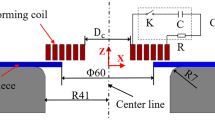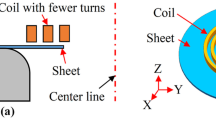Abstract
Hole flanging is a forming method used to produce local features on metal sheets. In traditional stamping, the diameter of prefabricated hole should be reduced to improve flanging height. But when the prefabricated hole is too small, the flanging hole is prone to crack in the forming process. Electromagnetic forming (EMF) is a high-speed forming method based on pulsed magnetic forces, which can significantly improve the forming limit of materials. In order to improve the flanging height and forming accuracy, a composite forming method is proposed, which combines multi-directional electromagnetic flanging (MDEMF) and shaping process by punch. The material flow in the blank holder area is promoted by radial electromagnetic force, and the flanging height is increased. The effects of coil current direction and discharge voltage on the magnetic field are investigated. If the current flows in the same direction, a larger magnetic force can be generated on the sheet. The higher the discharge voltage, the better the material flow in the sheet flange. Then shaping process by punch was used to ensure the forming accuracy of flanged parts. In the same initial hole diameter conditions, the forming height achieved by MDEMF + shaping process was improved by 89.5% compared to that by traditional stamping.






















Similar content being viewed by others
Availability of data and material
All data generated or analyzed during this study are included in this published article.
Code availability
Not applicable.
References
Chen TC (2007) An analysis of forming limit in the elliptic hole-flanging process of sheet metal. J Mater Process Tech 192–193:373–380
Huang YM, Chien KH (2001) The formability limitation of the hole flanging process. J Mater Process Tech 117:43–51
Ou H, Sun SJ, Li PF, Li GY, Cui JJ (2021) A dynamic small-sized hole flanging process driven by Lorentz-force for aluminum alloys. Int J Mater Form 14(5):1019–1030
Sow CT, Bazin G, Heuzé T, Racineux G (2020) Electromagnetic flanging: from elementary geometries to aeronautical components. Int J Mater Form 13(3):423–443
Psyk V, Risch D, Kinsey BL, Tekkaya AE, Kleiner M (2011) Electromagnetic forming-a review. J Mater Process Tech 211(5):787–829
Tamhane AA, Altynova MM, Daehn GS (1996) Effect of sample size on ductility in electromagnetic ring expansion. Scr Metall Mater 34:1345–1350
Li F, Mo J, Li J, Huang L, Zhou H (2013) Formability of Ti-6Al-4V titanium alloy sheet in magnetic pulse bulging. Mater Des 52:337–344
Chen CJ (2019) Numerical Simulation and Experimental Study on Electromagnetic Hole-flanging Forming Process of Aluminum Alloy Sheet. Guangdong University of Technology, Guangzhou, p 2019
Yan ZQ, Xiao A, Cui XH, Lin YH, Yu HL, Chen BG (2021) Fracture behavior of 7075–T6 aluminum alloy under electromagnetic forming and traditional stamping. Arch Civ Mech Eng 21:134–148
Xiao A, Huang CQ, Yan ZQ, Cui XH, Wang SP (2022) Improved forming capability of 7075 aluminum alloy using electrically assisted electromagnetic forming. Mater Charact 183:111615
Cui XH, Mo JH, Li JJ, Xiao XT (2017) Tube bulging process using multidirectional magnetic pressure. Int J Adv Manuf Tech 90(5–8):2075–2082
Cui XH, Li JJ, Mo JH, Fang JX, Zhou B, Xiao XT, Feng F (2016) Incremental electromagnetic-assisted stamping (IEMAS) with radial magnetic pressure: a novel deep drawing method for forming aluminum alloy sheets. J Mater Process Tech 233:79–88
Fang JX, Mo JH, Cui XH, Li JJ, Zhou B (2016) Electromagnetic pulse-assisted incremental drawing of aluminum cylindrical cup. J Mater Process Tech 238:395–408
Yan ZQ, Xiao A, Cui XH, Guo YZ, Lin YH, Zhang L, Zhao P (2021) Magnetic pulse welding of aluminum to steel tubes using a field-shaper with multiple seams. J Manuf Process 65:214–227
Zhou Y, Tan JW, Yao CG (2018) Finite-Element simulation and experiments on plastic heating in the process of electromagnetic pulse forming. IEEE T Plasma Sci 46:1–11
Tian Y, Huang L, Ma HJ, Li JJ (2013) Establishment and comparison of four constitutive models of 5A02 aluminium alloy in high-velocity forming process. Mater Design 54:587–597
Feng F, Li JJ, Huang L, Su HL, Li HZ, Zhang YJ, Cao SJ (2021) Formability enhancement of 5052 aluminium alloy sheet in electromagnetic impaction forming. Int J Adv Manuf Tech 112(9–10):2639–2655
Cui XH, Zhang ZW, Yu HL, Xiao XT, Cheng YQ (2019) Springback Calibration of a U-Shaped Electromagnetic Impulse Forming Process. Metals-Basel 9(5):603–615
Yan ZQ, Lin L, Chen Y, Cui XH, Ye SP, Qiu DY, Zhang L (2022) Electromagnetic flanging using a field shaper with multiple seams. Int J Adv Manuf Tech 120:1747–1763
Funding
This work was supported by the National Natural Science Foundation of China (Grant Number: 51775563) and the Project of State Key Laboratory of High Performance Complex Manufacturing, Central South University (ZZYJKT2020-02).
Author information
Authors and Affiliations
Contributions
Ziqin Yan contributed to methodology, investigation, simulation, experiments, and writing original draft. Xiaohui Cui contributed to methodology, investigation, and writing—review and editing. Ang Xiao collected data and performed investigation. Jiajia Ding performed investigation. Dongyang Qiu contributed to experiments.
Corresponding author
Ethics declarations
Ethics approval
Not applicable.
Consent to participate
Written informed consent for publication was obtained from all participants.
Consent for publication
Written informed consent for publication was obtained from all participants.
Conflict of interest
The authors declare no conflict of interest.
Additional information
Publisher's Note
Springer Nature remains neutral with regard to jurisdictional claims in published maps and institutional affiliations.
Rights and permissions
Springer Nature or its licensor holds exclusive rights to this article under a publishing agreement with the author(s) or other rightsholder(s); author self-archiving of the accepted manuscript version of this article is solely governed by the terms of such publishing agreement and applicable law.
About this article
Cite this article
Yan, Z., Cui, X., Xiao, A. et al. Improvement of circular hole flanging height using multi-directional electromagnetic flanging. Int J Adv Manuf Technol 122, 1281–1292 (2022). https://doi.org/10.1007/s00170-022-09971-x
Received:
Accepted:
Published:
Issue Date:
DOI: https://doi.org/10.1007/s00170-022-09971-x




